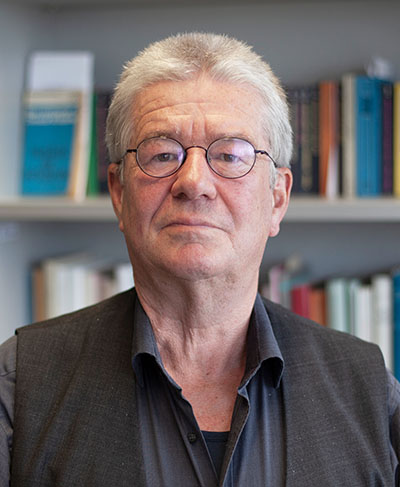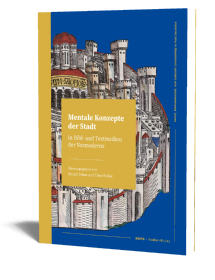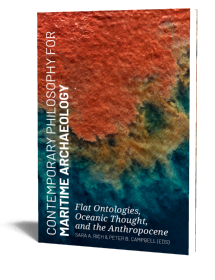Epistemology, Economics, and Ethics
A Practical Philosophy of Prehistoric Archaeology
Konrad Ott | 2023

Epistemology, Economics, and Ethics
A Practical Philosophy of Prehistoric Archaeology
Konrad Ott | 2023
Paperback ISBN: 9789464270815 | Hardback ISBN: 9789464270822 | Imprint: Sidestone Press Academics | Format: 210x280mm | 256 pp. | ROOTS Studies 04 | Series: ROOTS Studies | Language: English | 0 illus. (bw) | 0 illus. (fc) | Keywords: archaeology; epistemology; concept formation; historical materialism; Anthropocene; ethics | download cover | DOI: 10.59641/v9144yh
Read online or downloaded 1027 times
-
Digital & Online access
This is a full Open Access publication, click below to buy in print, browse, or download for free.
-
Buy via Sidestone (EU & UK)
-
Buy via our Distributors (WORLD)
For non-EU or UK destinations you can buy our books via our international distributors. Although prices may vary this will ensure speedy delivery and reduction in shipping costs or import tax. But you can also order with us directly via the module above.
UK international distributor
USA international distributor
-
Bookinfo
Paperback ISBN: 9789464270815 | Hardback ISBN: 9789464270822 | Imprint: Sidestone Press Academics | Format: 210x280mm | 256 pp. | ROOTS Studies 04 | Series: ROOTS Studies | Language: English | 0 illus. (bw) | 0 illus. (fc) | Keywords: archaeology; epistemology; concept formation; historical materialism; Anthropocene; ethics | download cover | DOI: 10.59641/v9144yh
Read online or downloaded 1027 times

We will plant a tree for each order containing a paperback or hardback book via OneTreePlanted.org.
This book is intended to be a groundwork of how to theorise prehistory and archaeology and how to make connectivities between the past and the present. It is divided into four parts. The first part is epistemological. It explains why there must be theoretical investments if past ways of human life are to be understood and explained. This insight is specified to a ladder-model (sensu Hawkes) with conceptual scaffoldings on each step. Stepwise, sets of concepts are introduced. This constitutes a reflective turn for archaeologists by showing how theoretical investments can be justified, substantiated and rejected. The second part makes a specific investment: original historical materialism. It claims that the Neolithic transformation makes humans economic agents. Stepwise, economic agency and its categories must have come to mind to earlier humans once they started to “produce”. This part harbours Marx’s idea that modern economic theories help to explain archaic economic activities. The third part claims that the Anthropocene originates within the Neolithic transformation. A chorus song of Sophocles is taken as an intellectual spike of the early Anthropocene. Crucial qualitative achievements of the Neolithic transformation can be expanded in their quantities without intrinsic limitations. Under modern boundary conditions, such expansions transform into the “Great Acceleration”. If so, the current trajectories of growth have deep roots. Given this ongoing transformation into the Anthropocene, a concept of responsibility becomes unavoidable. This concept grounds the fourth part that asks for ethical principles for a “good” Anthropocene in different fields of policy-making. A focus is laid on adaptation to climatic change. Some ethical building blocks for a second axial age are proposed. The book concludes with reflections upon heterarchical modes of life and upon the lifeworld of practical reasons.
Preface of the series editors
Preface of the author
Introduction: What the book is all about
Part 1: Epistemology: Scaffolding on a ladder
1.1 Ethics, reflection, and transcendental pragmatics
1.2 History and archaeology
1.3 Basic suppositions and distinctions
1.4 The universal, the particular, and the individual
1.5 The concept of transformation
1.6 A brief history of theory formation in prehistoric archaeology (PA)
1.7 Understanding, explaining, and the role of reasons
1.8 The practical interest in history
1.9 Antinomies and resolutions
1.10 Theoretical investments
1.11 Scaffolding on a ladder, stepwise
1.12 Results of the analysis: Sets of concepts
Part 2: Historical materialism reloaded: The transformative emergence of economic life
2.1 Historical materialism reloaded
2.2 Claim
2.3 Investing economic theories
2.4 On Marxian legacies in contemporary historical materialism
2.5 Explaining the thesis in detail
2.6 Household economics and the domestic mode of production
2.7 Anatomy of economic transformation
2.8 Result: Emergence of economic life and the “thin” Anthropocene
Part 3: Origins of the Anthropocene in the Neolithic
3.1 Introduction and outline
3.2 Challenges of the Anthropocene
3.3 Sophocles: The chorus song in the “Antigone”
3.4 The eclipse of qualities into quantities
3.5 Preliminary results
Part 4: Prehistoric archaeology and contemporary ethics: Prospects for a “good” Anthropocene
4.1 Diagnosis
4.2 Program and claim
4.3 Normative investments
4.4 Universalism and particularism
4.5 Ethical framework
4.6 Why and how a second axial age should be different
4.7 “Greening” the Anthropocene with the help of prehistoric archaeology (PA)
4.8 On degrowth theories
4.9 Outline of the method: Historical laboratories and “do-it-yourself” strategies
4.10 Ways ahead
4.11 Results and outlooks: System and lifeworld
References
Abbreviations

Prof. Dr. Konrad Ott
Konrad Ott is a full professor for environmental philosophy and ethics at Kiel University. He wrote a PhD thesis on the origins and the discursive logic of scientific history. His current fields of research are environmental ethics, climate ethics, sustainability, nature conservation, discourse theory, and philosophy of history. Konrad Ott is a PI of the Reflective Turn Forum of the ROOTS Cluster of Excellence.
Abstract:
This book is intended to be a groundwork of how to theorise prehistory and archaeology and how to make connectivities between the past and the present. It is divided into four parts. The first part is epistemological. It explains why there must be theoretical investments if past ways of human life are to be understood and explained. This insight is specified to a ladder-model (sensu Hawkes) with conceptual scaffoldings on each step. Stepwise, sets of concepts are introduced. This constitutes a reflective turn for archaeologists by showing how theoretical investments can be justified, substantiated and rejected. The second part makes a specific investment: original historical materialism. It claims that the Neolithic transformation makes humans economic agents. Stepwise, economic agency and its categories must have come to mind to earlier humans once they started to “produce”. This part harbours Marx’s idea that modern economic theories help to explain archaic economic activities. The third part claims that the Anthropocene originates within the Neolithic transformation. A chorus song of Sophocles is taken as an intellectual spike of the early Anthropocene. Crucial qualitative achievements of the Neolithic transformation can be expanded in their quantities without intrinsic limitations. Under modern boundary conditions, such expansions transform into the “Great Acceleration”. If so, the current trajectories of growth have deep roots. Given this ongoing transformation into the Anthropocene, a concept of responsibility becomes unavoidable. This concept grounds the fourth part that asks for ethical principles for a “good” Anthropocene in different fields of policy-making. A focus is laid on adaptation to climatic change. Some ethical building blocks for a second axial age are proposed. The book concludes with reflections upon heterarchical modes of life and upon the lifeworld of practical reasons.
Contents
Preface of the series editors
Preface of the author
Introduction: What the book is all about
Part 1: Epistemology: Scaffolding on a ladder
1.1 Ethics, reflection, and transcendental pragmatics
1.2 History and archaeology
1.3 Basic suppositions and distinctions
1.4 The universal, the particular, and the individual
1.5 The concept of transformation
1.6 A brief history of theory formation in prehistoric archaeology (PA)
1.7 Understanding, explaining, and the role of reasons
1.8 The practical interest in history
1.9 Antinomies and resolutions
1.10 Theoretical investments
1.11 Scaffolding on a ladder, stepwise
1.12 Results of the analysis: Sets of concepts
Part 2: Historical materialism reloaded: The transformative emergence of economic life
2.1 Historical materialism reloaded
2.2 Claim
2.3 Investing economic theories
2.4 On Marxian legacies in contemporary historical materialism
2.5 Explaining the thesis in detail
2.6 Household economics and the domestic mode of production
2.7 Anatomy of economic transformation
2.8 Result: Emergence of economic life and the “thin” Anthropocene
Part 3: Origins of the Anthropocene in the Neolithic
3.1 Introduction and outline
3.2 Challenges of the Anthropocene
3.3 Sophocles: The chorus song in the “Antigone”
3.4 The eclipse of qualities into quantities
3.5 Preliminary results
Part 4: Prehistoric archaeology and contemporary ethics: Prospects for a “good” Anthropocene
4.1 Diagnosis
4.2 Program and claim
4.3 Normative investments
4.4 Universalism and particularism
4.5 Ethical framework
4.6 Why and how a second axial age should be different
4.7 “Greening” the Anthropocene with the help of prehistoric archaeology (PA)
4.8 On degrowth theories
4.9 Outline of the method: Historical laboratories and “do-it-yourself” strategies
4.10 Ways ahead
4.11 Results and outlooks: System and lifeworld
References
Abbreviations

Prof. Dr. Konrad Ott
Konrad Ott is a full professor for environmental philosophy and ethics at Kiel University. He wrote a PhD thesis on the origins and the discursive logic of scientific history. His current fields of research are environmental ethics, climate ethics, sustainability, nature conservation, discourse theory, and philosophy of history. Konrad Ott is a PI of the Reflective Turn Forum of the ROOTS Cluster of Excellence.
-
Digital & Online access
This is a full Open Access publication, click below to buy in print, browse, or download for free.
-
Buy via Sidestone (EU & UK)
-
Buy via our Distributors (WORLD)
For non-EU or UK destinations you can buy our books via our international distributors. Although prices may vary this will ensure speedy delivery and reduction in shipping costs or import tax. But you can also order with us directly via the module above.
UK international distributor
USA international distributor
- Browse all books by subject
-
Search all books

We will plant a tree for each order containing a paperback or hardback book via OneTreePlanted.org.
You might also like:
© 2025 Sidestone Press KvK nr. 28114891 Privacy policy Sidestone Newsletter Terms and Conditions (Dutch)








